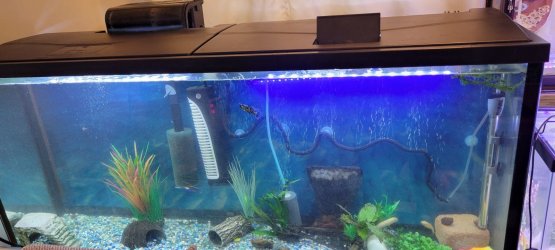lk112373
New Member
Hello fish lovers!
I am a 65 year old female and now retired so I can spend a little time taking better care of my fish.
I have had at least one tank of fish for 15 years. I started with a common pleco and two shibunkins, they thrived very well in my 25 gal. aquarium. I added another common pleco because the first one looked lonely!
After a few years,they got enormous! And so did the shibunkins. At that time I added a 45 gal tank and they continued to grow, I finally found someone to take them as the ammonia was killing my other fish. I had gotten a couple of mollies in 2018 dalmatian and mickey mouse the dalmatian became totally black and very big, she had 3 different groups of babies and the one of the tuxedo miles gave birth also. I added another 7 gal so they could have more room. The first one is still alive! I have gotten bristlenose, bettas & copies and 9 tanks! My bristlenose have had several clutches and I have so many babies but I don't know where to sell them, only one local shop will do so and he only wants 25 at a time and 2 months old, I have to do something with them!
I have never had a problem with water quality until the last 2 weeks, my plecos are dying! I have checked for ph, ammonia, nitrites & nitrates, all in safe range. I added ammo lock when the ammonia was more than 0. And test strips show safe also.
I lost about 100 babies (2 months) and almost all the adults (1 left) mother of all babies, but I still have 50+ babies in a 3 gal nursery and need to move to bigger tank, but I'm still afraid of the water quality. My mollies and platies are all still alive and the bettas were in separate tank. Not sure what else to check the babies were just dead when I woke up one day all at once! I have also made water changes every other day since then. Sorry so long!
I am a 65 year old female and now retired so I can spend a little time taking better care of my fish.
I have had at least one tank of fish for 15 years. I started with a common pleco and two shibunkins, they thrived very well in my 25 gal. aquarium. I added another common pleco because the first one looked lonely!
After a few years,they got enormous! And so did the shibunkins. At that time I added a 45 gal tank and they continued to grow, I finally found someone to take them as the ammonia was killing my other fish. I had gotten a couple of mollies in 2018 dalmatian and mickey mouse the dalmatian became totally black and very big, she had 3 different groups of babies and the one of the tuxedo miles gave birth also. I added another 7 gal so they could have more room. The first one is still alive! I have gotten bristlenose, bettas & copies and 9 tanks! My bristlenose have had several clutches and I have so many babies but I don't know where to sell them, only one local shop will do so and he only wants 25 at a time and 2 months old, I have to do something with them!
I have never had a problem with water quality until the last 2 weeks, my plecos are dying! I have checked for ph, ammonia, nitrites & nitrates, all in safe range. I added ammo lock when the ammonia was more than 0. And test strips show safe also.
I lost about 100 babies (2 months) and almost all the adults (1 left) mother of all babies, but I still have 50+ babies in a 3 gal nursery and need to move to bigger tank, but I'm still afraid of the water quality. My mollies and platies are all still alive and the bettas were in separate tank. Not sure what else to check the babies were just dead when I woke up one day all at once! I have also made water changes every other day since then. Sorry so long!





